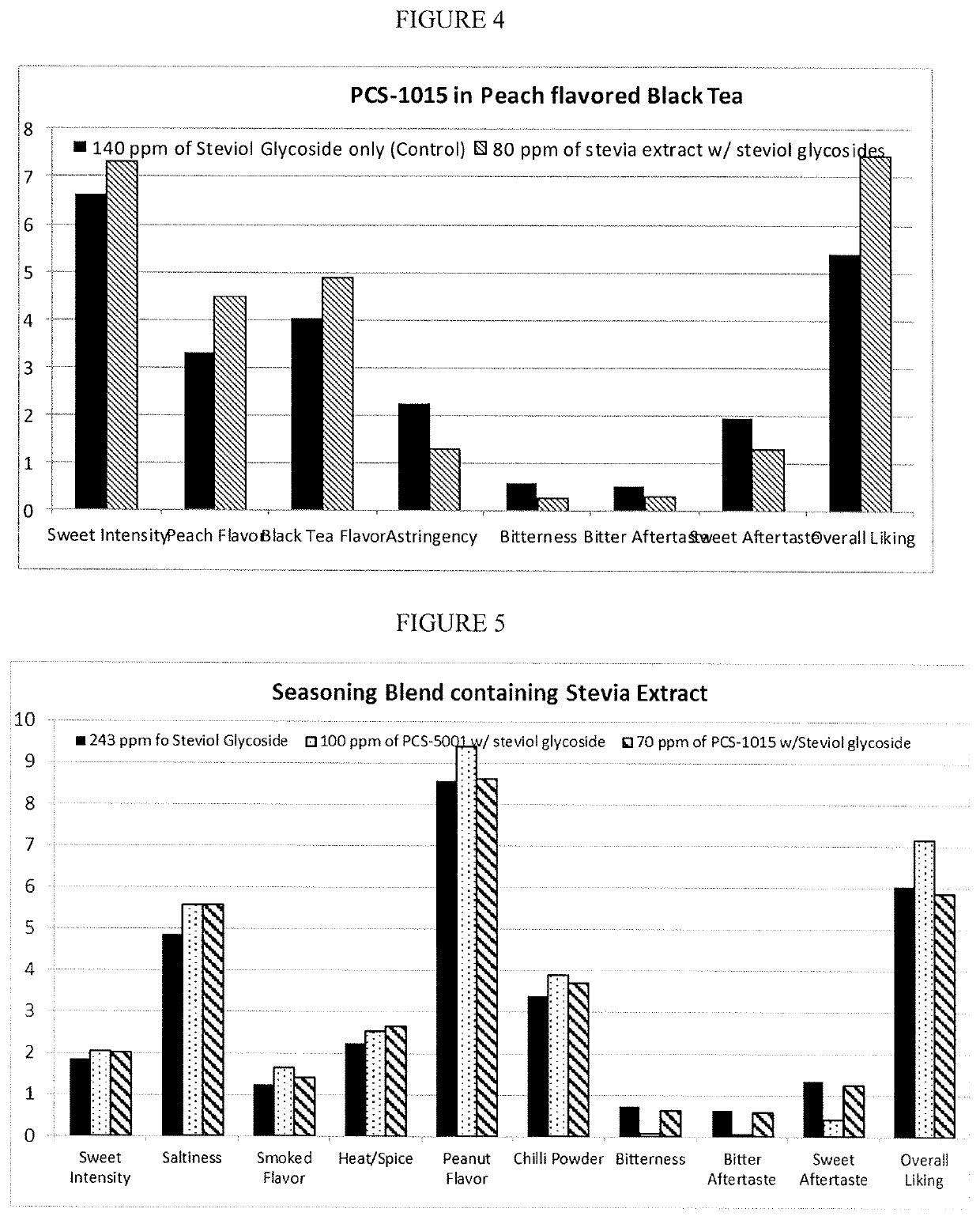Stevia extract containing selected steviol glycosides as flavor, salty and sweetness profile modifier
a technology of steviol glycosides and stevia extracts, which is applied in the field of stevia extracts as flavor modifiers, can solve problems such as temporal and/or flavor profiles that are not uniform, and achieve the effects of improving taste and palatability, improving the organoleptic properties of medical foods, and increasing the taste and flavor intensity of medical foods
- Summary
- Abstract
- Description
- Claims
- Application Information
AI Technical Summary
Benefits of technology
Problems solved by technology
Method used
Image
Examples
example 1a
Detection of Concentration Threshold for Sweetness Recognition
[0031]To detect the sweetness recognition level of PCS-5001 (stevia extract), the test method outlined by Harman, et al (Food Technology, November 2013) was used with ten trained panelists that have been previously qualified for their taste acuity and trained in the use of a sweetness intensity rating scale, evaluated a series of aqueous solutions of sucrose and the stevia extract (PCS-5001 or PCS-1015) at room temperature; the sucrose solutions of 1.5% concentration and the stevia extract solutions with concentrations ranging between 100 and 120 ppm for PCS-5001 and 70-80 ppm for PCS-1015 were prepared with filter water. The objective of the test was to determine the sweetness recognition level of the stevia extract. The evaluations were done in triplicate using the same panelists so that a total of 30 values were generated for each average data point.
[0032]The samples were coded and presented in random order to panel me...
example 1b
Sweetness Detection of Concentration Threshold for Sweetness Detection
[0035]The ten panel members evaluated a series of lemon-lime flavored carbonated soft drink (CSD) sweetened with sucrose and STEVIA EXTRACT at room temperature; the evaluations were done in triplicate using the same panelists so that at least 30 values were generated for each average data point. The lemon lime flavored carbonated soft drink control sample had 1.5% sucrose concentration and the test sample contained STEVIA EXTRACT (PCS-5001) with concentrations at 110 and 120 ppm or STEVIA EXTRACT (PCS-1015) with concentrations of 70 and 90 ppm. Other ingredients in the CSD samples were citric acid, lemon-lime flavor, sodium benzoate, potassium citrate and xanthan gum. The objective of the test was to determine the sweetness detection limit of STEVIA EXTRACT. Tests were conducted as outlined in Example 1A.
[0036]The samples with 120 ppm PCS-5001 (STEVIA EXTRACT) and 90 ppm PCS-1015 (STEVIA EXTRACT) showed no signifi...
example 2
Effect of Stevia Extract on Flavor Modification in a Typical Carbonated Soft Drink Application
[0038]A cola flavored carbonated soft drink was developed to evaluate the effect of PCS-5001 and PCS-1015 (stevia extract) on the sweetness and flavor profile of the beverage that was sweetened with sugar and stevia sweetener to achieve 30% sugar reduction (Table 6). The samples with and without PCS-5001 or PCS-1015 were evaluated by thirty consumer panel members, who assigned relative values to each sample for overall Liking, sweetness, vanilla flavor, brown note, and aftertaste on a 10-pt continuous intensity scale as outlined in Table 7.
[0039]
TABLE 6Cola flavored Soft drink for sensory evaluationControl:Test: 30% SugarTest: 30% SugarCOLA BEVERAGE30% SugarReduction withReduction withFORMULAReductionPCS-5001PCS-1015Water91.6891.6791.67Sugar7.897.897.89Cola Flavor -0.3750.3750.375Flavor SystemsPhosphoric Acid0.03330.03330.033385%Caffeine0.01000.01000.0100Stevia glycoside0.01000.01000.0100PC...
PUM
| Property | Measurement | Unit |
|---|---|---|
| weight | aaaaa | aaaaa |
| concentrations | aaaaa | aaaaa |
| dry weight | aaaaa | aaaaa |
Abstract
Description
Claims
Application Information
 Login to View More
Login to View More - R&D
- Intellectual Property
- Life Sciences
- Materials
- Tech Scout
- Unparalleled Data Quality
- Higher Quality Content
- 60% Fewer Hallucinations
Browse by: Latest US Patents, China's latest patents, Technical Efficacy Thesaurus, Application Domain, Technology Topic, Popular Technical Reports.
© 2025 PatSnap. All rights reserved.Legal|Privacy policy|Modern Slavery Act Transparency Statement|Sitemap|About US| Contact US: help@patsnap.com



